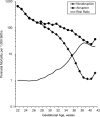Placental abruption and perinatal mortality with preterm delivery as a mediator: disentangling direct and indirect effects
- PMID: 21430195
- PMCID: PMC3159429
- DOI: 10.1093/aje/kwr045
Placental abruption and perinatal mortality with preterm delivery as a mediator: disentangling direct and indirect effects
Abstract
The authors use recent methodology in causal inference to disentangle the direct and indirect effects that operate through a mediator in an exposure-response association paradigm. They demonstrate how total effects can be partitioned into direct and indirect effects even when the exposure and mediator interact. The impact of bias due to unmeasured confounding on the exposure-response association is assessed through a series of sensitivity analyses. These methods are applied to a problem in perinatal epidemiology to examine the extent to which the effect of abruption on perinatal mortality is mediated through preterm delivery. Data on over 26 million US singleton births (1995-2002) were utilized. Risks of mortality among abruption and nonabruption births were 102.7 and 6.2 per 1,000 births, respectively. Risk ratios of the natural direct and indirect (preterm delivery-mediated) effects of abruption on mortality were 10.18 (95% confidence interval: 9.80, 10.58) and 1.35 (95% confidence interval: 1.33, 1.38), respectively. The proportion of increased mortality risk mediated through preterm delivery was 28.1%, with even higher proportions associated with deliveries at earlier gestational ages. Sensitivity analyses underscore that the qualitative conclusions of some mediated effects and substantial direct effects are reasonably robust to unmeasured confounding of a fairly considerable magnitude.
Figures


Comment in
-
Point: Risk Ratio Equations for Natural Direct and Indirect Effects in Causal Mediation Analysis of a Binary Mediator and a Binary Outcome-A Fresh Look at the Formulas.Am J Epidemiol. 2019 Jul 1;188(7):1201-1203. doi: 10.1093/aje/kwy275. Am J Epidemiol. 2019. PMID: 30590386
-
Counterpoint: Mediation Formulas With Binary Mediators and Outcomes and the "Rare Outcome Assumption".Am J Epidemiol. 2019 Jul 1;188(7):1204-1205. doi: 10.1093/aje/kwy281. Am J Epidemiol. 2019. PMID: 30590417 Free PMC article.
References
-
- Robins JM, Greenland S. Identifiability and exchangeability for direct and indirect effects. Epidemiology. 1992;3(2):143–155. - PubMed
-
- Pearl J. Direct and indirect effects. In: Breese JS, Koller D, editors. Proceedings of the 17th Conference in Uncertainty in Artificial Intelligence. San Francisco, CA: Morgan Kaufmann Publishers, Inc; 2001. pp. 411–420.
-
- VanderWeele TJ, Vansteelandt S. Conceptual issues concerning mediation, interventions and composition. Stat Interface—Spec Issue Mental Health Soc Behav Sci. 2009;2:457–468.

